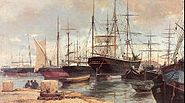Guglielmo Micheli

Guglielmo Micheli (Livorno, October 12, 1866 - Livorno, September 7, 1926) was an Italian painter. Micheli's work consisted mainly of landscapes and seascapes using oils and watercolors.[1]
Biography
Micheli was awarded a stipend named in honor of artist Michelangelo Bastoni, allowing him to enroll at the Academy of Fine Arts of Florence, where he was a pupil of Natale Betti. The school was then directed by Giovanni Fattori. He frequently wrote to Giuseppe Pellizza da Volpedo,[2] who had been a fellow student at the academy, along with Plinio Nomellini, Mario Puccini, Francesco Fanelli, and Ferruccio Pagni.[3] Influenced by Volpedo and others, Micheli initially painted in a style recalling the Macchiaioli painters, before developing his own style. He also made engravings and designed illustrations for books.
In 1888, he married Guglielmina Paganucci, granddaughter of the prominent sculptor of Livorno, Giovanni Paganucci.[4]
His most prominent pupil would end up being Amedeo Modigliani. Among his other pupils were Llewelyn Lloyd, Giulio Cesare Vinzio, Manlio Martinelli, Gino Romiti, Renato Natali and occasionally Oscar Ghiglia (painter).[5]

Selected paintings
-
White Oxen
-
Port of Livorno
References
- ^ Treccani Encyclopedia Dizionario Biografico degli Italiani - Volume 74 (2010); biography by Laura Mocci.
- ^ conference about the letters between Micheli and Pelizza da Volpedo
- ^ L. Mocci, Treccani Encyclopedia.
- ^ L. Mocci, Treccani Encyclopedia.
- ^ Pinacoteca Livorno short biography.
800artstudio biography by Gioela Massagli, and translated by: Catherine Biggerstaff.


